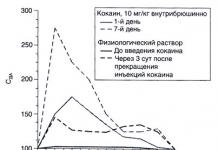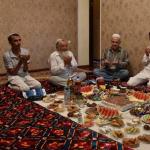New times raise new questions. Society changes - attitudes towards the subjects studied change. History in this regard is most subject to change. The volume of information being studied has increased, the source base has expanded, and different points of view on the same events have appeared in textbooks. In this regard, a natural question arose: is the child able to remember and assimilate this entire amount of information? Today, teachers and methodologists are looking for ways to improve the effectiveness of teaching.
I have always been concerned with the problem of how to make sure that everyone is interested in the lesson, so that everyone is involved in the learning process, and no one is left indifferent. Is it possible to avoid the general tendency to view history teaching as the absorption of a certain amount of knowledge? How can we use history to develop a student’s personality, his creative thinking, the ability to critically analyze the past and present, and draw his own conclusions?
Apparently, the main goal of teaching history at school is the self-development of the student as an individual, as a cultural and historical subject. History should confront students with problems of moral choice, showing the complexity and ambiguity of assessments of a historical event. Students must receive the right to subjectivity and partiality of judgment, to substantiate their solutions to moral problems of history.
History is one of the most important, core humanities subjects in school, where the intellectual skills necessary for a student are formed. To write an essay,download history presentation or make a report on a given topic, you need to learn how to work with any text, be able to select the main thing from it, highlight the main idea, compare texts, and analyze.
Is it always interesting for a student to work with a textbook? Probably not. This depends on your interest in the subject and your ability to work with a book economically and effectively in terms of results. At the same time, it should be remembered that the history lesson is one of the few where students acquire communication skills, where an atmosphere of creativity easily arises, where they can organize a discussion of what they have read, educational games, and problem solving.
Students must also be taught to listen to each other, ask and answer questions. It is hardly appropriate to use a single technology here, just work with the source or solve problems. We must not forget about the living word of the teacher, about his emotional, vivid story, which will arouse interest in a particular topic or problem. Modern education must be based on interest, taking into account the psychological characteristics of children.
We all know that there are children who have difficulty speaking in front of a class. And others, on the contrary, never close their mouths, which sometimes greatly disturbs the teacher, because they divert all the attention only to themselves. And there are also those who have read the entire textbook a long time ago, enjoy reading additional literature and have a stable cognitive interest.
With this in mind, when learning new materialYou can use a form of group work that will make it possible to approach each child in a differentiated manner, taking into account psychological characteristics and individualization of learning.
Students are divided into three groups.The first group is editors. They compose short factual articles for the encyclopedic dictionary. They need to restore the logic of events using only a textbook. For this category of students, written assignments will be the main focus.
The second group is journalists. They will create vivid images of events and talk about personalities. As a rule, they are rarely satisfied with one textbook; they have a desire to learn as much as possible. Their work will be dominated by oral responses.
The third group is historians. They will have to explain the most difficult and controversial issues, topics, terms, and concepts. They are entrusted with the responsibility of preparing a debate, a “round table” on a given topic. This group cannot do without additional literature.
Interest is the child’s attitude to the subject, it is a manifestation of cognitive, mental actions. These actions have an emotional connotation, which is expressed more vividly and positively the more successful the cognitive activity is.
For example, children in grades V - VI love it when there are playful moments in the lesson, an emotional story from the teacher, situations are perceived through their own “I” (for example, “I’m visiting someone,” “I’m interviewing someone.” ", etc.).
Techniques such as:
- question and answer game(questions are asked to each other in a chain). This is a test of home materials by the children themselves. To ask a question, you need to know what you have read well, be able to clearly and clearly formulate your thoughts, and answer logically;
- compiling various versions of screening tests on the covered topic. Children turn to the text of the textbook, learn to choose the main thing and formulate their thoughts;
- writing a short article for an encyclopedia, selecting main events, dates, personalities, judgments. This is one of the techniques that allows you to develop the ability to independently write an article, report, abstract;
- use of words given by the teacher to compose a story;
- highlighting keywords in the covered topic.
Options for group work in the lesson:
- restoration of the chain of events(one of the students begins the story, the other continues);
- text with errors(forms the ability to listen and hear);
Auction of names (determine which event is associated with a historical figure);
- story about an event based on illustration.
Let's look at some of the tasks I use as an example.final lesson on the topic “Early Middle Ages”(VI class). The form of work is group.
I. Using the words given by the teacher, compose a story.
1. The Great Migration of Peoples (task for the first group): Caesar, legions, Germany, Limes, Huns, Visigoths, division of the Roman Empire, the battle of Adrianople, Alaric, Honorius, 410, Attila, the battle of the Catalaunian fields, vandals, Romulus Augustulus, 476, Lombards, Franks.
2. Frankish kingdom (task for the second group): Gaul, Franks, Clovis, Sou-Asson bowl, mayordomo, customary law, Salic truth.
3. Empire of Charlemagne (task for the third group): Carolingians, Charles Martell, battle of Poitiers, benefices, Charlemagne, campaigns, emperor, empire, administration, palace Academy, Alcuin, Carolingian Renaissance.
Each group reviews the answer of the previous one, taking into account the correct use of terms and concepts, the logic of events, and the form of presentation.
II. Quiz.
And “What they talk about at the court of Charlemagne.”
1. What was the meaning of Charles Martel’s military reform?
2. Why did Charlemagne proclaim himself emperor?
3. Why did the state of Charlemagne not have a permanent capital?
4. What nations were part of the empire of Charlemagne?
5. What is the Carolingian Revival?
6. What was the name of Charlemagne's closest adviser? What role did he play at court?
7. When and why did Charlemagne's empire collapse?
8. What threats did European society face in the 9th-10th centuries?
9. How could new dangers be countered?
10. Anticipate how external and internal threats will change the face of Europe.
B. “What Scheherazade told.”
1. What is the name of the peninsula that is the homeland of the Arabs?
2. What is the name of the main Muslim sanctuary?
3. What was the name of the highest official who helped the caliph in governing the state?
4. What is the art of beautiful and elegant writing called?
5. Name the main religious precepts of Islam.
6. What is a mosque, madrasah?
7. Why did calligraphy become the main art of Muslims?
8. What duties and prohibitions does Islam impose on a Muslim?
9. What scientific discoveries were made in the Arab-Muslim East?
10. Why did the Arabs not develop sculpture and painting?
III. Individual, differentiated tasks.
A. Do you agree with these statements?
1. IV-VII centuries. - the time of the Great Migration of Peoples.
2. The state of Clovis was based on a clear set of laws.
3. The Treaty of Verdun was signed in the 12th century.
4. At the court of Charlemagne, a society for scientific knowledge arose - the Academy.
5. The largest expansion of the borders of the Byzantine Empire was under Emperor Vasily II.
6. The time of Charlemagne, when the rise of culture began, is called the early Renaissance.
7. The great scientist Ibn Sina is famous for his discoveries in the field of mathematics.
8. In his youth, Muhammad was a farmer.
9. Damascus became the capital of the caliphate
B. Make up semantic pairs of words.
The first group of words: Clovis, Charles Map-mew, Charlemagne, Justinian, Muhammad, mosque.
Second group of words: Alcuin, Soissons Chalice, arabesques, Medina, Hagia Sophia, Battle of Poitiers.
B. Make tests on the history of the early Middle Ages:
1) on the chronology of events;
2) to correlate the date and event;
3) to correlate the person and the event;
4) to establish a logical sequence of events.
D. Compare the kingdom of the Franks under Clovis and the empire of Charlemagne:
What territory did they own?
How was government organized?
What were the laws?
Name the fundamental differences between an empire and a kingdom.
IV. Questions for written answer,
What are the similarities and what are the differences in state formation between the Franks and the Arabs?
What role did religion play in the lives of the Franks, Byzantines and Arabs?
What do the reasons for the collapse of the empire of Charlemagne and the Arab Caliphate have in common?
V. Creative tasks.
A. Write a story:
“Charlemagne through the eyes of a court biographer”;
"One day at the court of the Caliph";
"Byzantium through the eyes of foreigners."
B. Write a short essay on behalf of a traveler"What I saw in Baghdad."
B. Compose an article for an encyclopedic dictionary on the topic.
"At the origins of medieval Europe."
"A Thousand Years of the Byzantine Empire."
"The New Faith of the Arabs."
In the classroom, as is known, the use of interactive teaching methods is very effective. The main ones among them are educational role-playing games, discussions, and joint solving of creative problems. The psychological reason for the activation of students’ cognitive activity using interactive methods lies in the uniqueness of the learning environment, in the joint activities of students and teachers. Below is the author'sdevelopment of educational role-playing game "Knight's Tournament"(VI class).
Target: generalization, repetition and consolidation of knowledge through immersion in the era in the form of a role-playing game.
Characters:king, queen, bishop, herald, knights, beautiful ladies.
Organizational momentIt is advisable that all characters in the game make at least one element of a medieval costume. “Knights” make armor, a shield with a coat of arms, a helmet, a spear, chain mail, a sword, create their family tree, “beautiful ladies” make an element of a headdress or dress.
Progress of the game
The king talks about the tournament that is to take place today, greets the knights and beautiful ladies.
The king also talks about his castle, based on the corresponding passage from W. Scott’s novel “Quentin Durward”:
“The castle was surrounded by a triple battlemented wall with fortified towers along its entire length and at the corners. The second wall was slightly higher than the first, and the third, inner, higher than the second, so that the outer ones could be defended from the inner walls if the enemy took possession of them. Around the first wall there was a ditch twenty feet deep, which was filled with water using sluices. There were exactly the same deep ditches around the two inner walls. Both the inner and outer banks of this triple row of ditches were surrounded by a palisade of thick iron rods, split at the ends into sharp teeth, which stuck out in all directions and made these ditches completely impregnable; attempting to climb over them would be tantamount to suicide.
In the center of this triple ring of walls stood the castle itself, which was a close group of buildings surrounding the oldest of these buildings - an ancient gloomy tower (donjon).
There was only one entrance to this impregnable stronghold - a gate pierced in the first outer wall, with two high towers on the sides, with a lowering portcullis and a drawbridge. There were exactly the same gates with towers in the two inner walls. In order to penetrate into the courtyard where the castle stood, it was necessary to pass through two dangerous narrow passages, fired from both sides, and take possession of three heavily fortified and carefully guarded gates.”
The Queen introduces the beautiful ladies, introduces the audience to the heralds, and talks about the initiation into heraldry.
Herald in German means herald. They monitored the correctness of the coat of arms, maintained order at the tournament, and checked the pedigree of the tournament participants. Becoming a herald was not easy. You had to serve as an assistant for seven long years before you earned the right to be ordained as a herald. During initiation, a cup of wine was poured onto the candidate's head, he took an oath and became a herald.
The king and queen also talk about the feast awaiting the winners after the tournament. You can use the description of the feast in the book by K.A. Ivanov “The Many Faces of the Middle Ages”:
“The horns sounded and they called for a ceremonial dinner. The entire glittering company heads to the huge table, hidden by a patterned white tablecloth. Casting a quick glance at the table setting, we notice with some amazement the absence of an item that, according to our concepts, is absolutely necessary - forks. The latter began to come into use only from the very end of the 13th century. Each utensil consists of a knife, a spoon and a silver, and sometimes gold, cup. There are cups for two persons. For everyone present at his device, white bread is placed on the table in advance. In addition, large metal goblets with wine, bowls with and without lids, salt shakers, and gravy boats are placed on the table. As soon as our baron’s guests sat down at the table, servants entered the hall; in their hands are jugs of water, towels are draped around their necks. Washing your hands before dinner in the absence of forks has, of course, a special sign. As for the dishes themselves, it should be noted that at that time there was no soup or broth; they started straight with meat. Today the first course is roasted deer; it is cut into pieces and heavily seasoned with hot pepper sauce. The second dish is just as satisfying as the first - fried wild boar with the same sauce. Behind him were fried peacocks and swans. While some servants and squires serve food, others go around the table with jugs and pour wine into goblets. Then hares and rabbits, all kinds of birds, pies with meat filling and fish are served. Here are apples, pomegranates, dates.
Some instructions for guests are interesting; guests should be modest and happy with what is offered to them; they should not eat with both hands; you should neither drink nor speak with your mouth full; do not ask your neighbor to borrow a cup if you see that he himself has not yet finished it.”
The bishop talks about the alliance of the king with the church, about the rite of knighting. The king girds one knight with a sword and hits him on the back of the head with his palm.
The heralds talk about the rules of the tournament. Each knight must have good weapons: armor, chain mail, armor, a helmet with a visor, a sword, a spear. Each knight has a coat of arms on his shield - his distinctive sign. Briefly, the heralds talk about the rules for drawing up coats of arms and the mottos on them.
Tournament rules: five instigator knights challenge everyone to a fight. Each knight from among the participants has the right to choose an opponent from among the instigators. To do this, he must touch his shield with his spear. Touching with a blunt end means that the knight wishes to compete with a blunt weapon. If a knight touches the shield with the tip of a spear, this means that he wants to fight to the death.
The heralds finish reading the rules with exclamations:Generosity, generosity, valiant knights. We chronicle the tournaments, and you should spare no expense for the historians of your exploits. Then the heralds read the genealogies of the knights and ask each of them to tell about their coat of arms.
Knights demonstrate their fighting skills and fight each other with swords.
The heralds announce the first winners of the tournament based on the duel. Then each knight talks about his coat of arms. The knights remaining after the fight must answer the questions asked by the king, queen, and beautiful ladies.
The ladies, in turn, talk about their outfits, read instructions prepared in advance at home to the young knight, talk about the traitorous knight and the code of knightly honor. Costume, artistry and storytelling style are judged.
Students can use the two passages below to help them prepare.
INSTRUCTIONS TO A NEW KNIGHT
They are obliged to serve their legitimate sovereign and defend him and their fatherland.
Let their shield be the refuge of the weak and oppressed, let their courage support everywhere and in everything the just cause of the one who turns to them.
May they never offend anyone and may they be afraid most of all to offend friendship, integrity, the absent, the mourning and the poor with slander.
Let the thirst for profit or gratitude, the love of honor, pride and vengeance not guide their actions. But may they be inspired everywhere and in everything by honor and truth.
May they not enter into an unequal battle: several against one, and may they avoid all deception and lies.”
J. Roy. "History of Chivalry"
TRAITOR KNIGHT
“On the platform erected in the center of the square stood the “king of coats of arms.” He was dressed in a magnificent ceremonial robe, representing the full coat of arms of the kingdom. Armorial fields of noble colors with heraldic figures located on them evenly hid the robe of the “king of coats of arms,” filling the wide, elbow-length sleeves, repeating both front and back. He stood erect and dignified, like the living embodiment of the greatness and honor of the kingdom.
Next to him on the scaffold stood a condemned knight dressed in full battle armor. In front of him on the table was fixed upside down a shield with his family coat of arms.
Everything became quiet, and the “King of Arms” began announcing the verdict. It lasted a long time.
A two-faced, evil, unfaithful knight, an oathbreaker and a liar, and as a sign of this his coats of arms are turned upside down. “And he and his descendants, forever,” sounded the herald’s voice.
The choir sang psalms. When the first psalm had sounded, the herald removed the helmet from the condemned man’s head and exclaimed
This is the helmet of a traitor knight!
A gasp ran through the crowd. After the second psalm, the herald freed the condemned man from the sword, then followed by the belt and spurs. The choir performed the funeral service for the condemned man, the herald proclaimed:
This is the traitor's sword. These are spurs.
And with each psalm, the herald removed another piece of armor from the condemned man, dishonoring him.
Finally, the turn came to the coat of arms, but not the one that hung upside down on the pillar, but the one that was with the knight’s armor. A ringing silence hung over the square. And in this silence the herald broke the shield into three parts with a hammer.
When the last psalm was finished, warm water was poured over the condemned man’s head. Silent and exhausted, he was carried to the nearest church to listen to the funeral service on his own. After that, he will be handed over to the royal judge, then handed over to the executioner, who will carry out the death sentence.
And along the streets of the city, stern heralds publicly announced that the descendants of the knight who had lost his honor had henceforth lost the right to be called noble people, wear coats of arms and participate in tournaments. And his coats of arms themselves will be unknown to descendants, just as something that never happened is unknown.
So, the traitor had to die as a commoner. They will not lead a horse covered with an armorial blanket to his burial, they will not carry a helmet crowned with a helmet emblem, a sword with engraved or enamel images of coats of arms on the handle or at the base of the blade, or a shield with family coats of arms. Heralds in long, toe-length mourning robes, with candles, on each of which is attached the coat of arms of the deceased, will not go near the hearse. And no coats of arms will adorn his tombstones or protect his grave.”
A.P. Chernykh. "A case from heraldry practice"
Questions that are asked to knights at the end of the tournament.
King.
1. What are the names of the rivers in whose basins the ancient Germans lived? (Elbe, Rhine.)
2. Distinctive sign of knights. (Coat of arms.)
3. Hereditary land ownership for service. (Feud.)
4. Abbot of the monastery. (Abbot.)
5. The work of a peasant in the lord's field. (Corvee.)
6. Roman province conquered by the Franks. (Gaul.)
Queen.
1. Shirt woven from iron rings. (Chain mail.)
2. Payments from peasants to the lord with products and products of their farm. (Obrok.)
3. The main tower of a feudal castle. (Donjon.)
4. The first king of the Franks (Clovis.)
5. The art of courtly behavior. (Courtiness.)
6. The person who received the fief. (Vassal.)
Bishop.
1. Horse warrior. (Knight.)
2. The name of the first Frankish emperor. (Charles.)
3. The art of beautiful, elegant writing among the Arabs. (Calligraphy.)
4. Armor made of iron plates. (Armour.)
5. The Holy Book of Muslims. (Koran.)
6. Symbol of power and dominance of the lords (Castle)
Herald.
1. Explain the expression “Castles are a symbol of the Middle Ages.”
2. What is knightly culture?
3. List the duties of peasants.
4. What is internal colonization?
5. What are the similarities between a tournament and a battle?
6. Why does generosity appear as a truly royal quality in romances of chivalry?
7. Formulate a code of knightly honor.
Additional questions that the teacher asks applicants for the title of tournament winner:
1. In an English proverb from the 13th century. It is said, “The senor does not sit at the table alone.” What feature of the behavior of a noble lord does it reflect?
2. How do you understand the German proverb: “Whoever remains in school until the age of 12 without riding is only fit to become a priest”?
3. Find the error in the text.
The castle was surrounded by a triple wall, with powerful towers along its entire length and in the corners. However, I walked into the castle calmly, no one stopped me. There were many buildings on the territory, half of them were wooden, so it took me a while to find the place I needed. The windows were large and wide, the floors were covered with expensive oriental carpets.
The one who answers most of the questions correctly will win the final match and be declared the winner. He chooses a beautiful lady from among those who received the most points for completing the task correctly.
Instructions
Set a triune task (goal) for the lesson. To do this, review the curriculum, re-read the explanatory note, and study the requirements of the standard on this topic. Formulate the goal and write it down in a plan so that it is clear to students. The educational component of the triune goal should equip students with a system of knowledge, skills and abilities.
Educational - to form in students a scientific worldview, moral personality traits, views and beliefs. Developmental - when teaching, to develop in students interest, creativity, will, emotions, speech, memory, attention, imagination, perception.
All elements of the lesson should contribute to achieving this goal.
Break the lesson down into its main components. Organizational - organization throughout the lesson, students’ readiness for, order and discipline. Target - setting learning goals for both the entire lesson and its individual stages. Motivational - the significance of the material being studied both in this course and and throughout the course. Communicative - the level of communication between the teacher and the teacher. Content - selection of material for study, consolidation, repetition, testing of knowledge. Technological - selection of forms, methods and teaching techniques that are optimal for a given type of lesson. Control and evaluation - use of assessment student activities. Analytical - summing up the lesson, analyzing the results.
Write a lesson plan. Please note its approximate content:
- The topic of the lesson, its goals and objectives, type, structure of the lesson, teaching methods and techniques, visual aids.
- Repetition at the beginning of the lesson of concepts, laws, checking homework, forms of knowledge control.
- Mastering new material: laws, concepts, solving problematic issues.
- Formation of specific skills and abilities in students, selection of types of oral and written work.
- Analysis of homework. When drawing up notes, take into account the characteristics of the class: level of preparedness, pace of work, attitude to the subject, general discipline, type of nervous system, emotionality.
Prepare for class immediately before the bell. To do this, mentally reproduce the main stages of the lesson, arrange the necessary material on the board, and think about the use of technical teaching aids. Decide which students you will interview. This work will allow you to save time during the lesson, make it more intense and clear.
To conduct a good lesson, fulfill the following important conditions. Study the lesson material well. If there are difficulties, sort them out before the lesson begins. Think through the lesson plan down to the smallest detail, choose the right variety of teaching methods. Try to present the material in an entertaining way. Use non-traditional lessons: travel, fairy tales, investigations. Watch your speech: it should be emotional, rich in intonations. Your facial expressions should be expressive and your gestures figurative. The pace of the lesson should be intense, but feasible for the student. If students cannot follow the presentation of the material, change the pace. Give tasks clearly, briefly, with the obligatory determination of how students understood the requirements.
There are conditions that make it difficult to teach a good lesson and hinder the achievement of results. Lack of confidence in your knowledge and an indifferent attitude towards everything that happens in the lesson will lead to loss of attention and weaken discipline. Monotonous teaching methods and the inability to work with them will negatively affect the result of the lesson. The material is poorly perceived if the teacher presents it dryly and monotonously. Never deviate from the topic of the lesson, do not get carried away with extraneous issues that are not related to the objectives of the lesson. Do not insult students. Don't interrupt, let them finish while answering. Support their initiative, approve of their activity.
Many novice teachers and student trainees at pedagogical universities experience fear of the student audience, uncertainty in their communication capabilities and doubts in their ability to establish contact with the class and position themselves as a teacher. If a young teacher fails to mobilize and gather his courage, even a methodically correctly designed lesson may be in danger of failure. And students can interpret the teacher’s timidity and indecisiveness as insufficient professionalism and lack of necessary competence.
It is necessary to prepare for the first lesson from the first day of study at a pedagogical university. Psychological preparation is very important; it is necessary to participate in a variety of scientific conferences, where students can observe and practice techniques for working with an audience. To cope with the fear of public speaking, it is useful to participate in student amateur performances, KVN, competitions, and even simply ask questions to the teacher during a lecture.
Lesson preparation
Confidence is usually boosted by the presence of the following components of a good lesson:
- An impeccable appearance, which naturally begins with the bathroom and hygiene procedures. This point should not be underestimated, because... Students always evaluate the teacher’s appearance and are quite critical of existing shortcomings. Some mistake, an awkward detail can become the reason for the teacher to have a nickname and a reason for ridicule. The optimal suit for a man is a classic business suit with a tie; for a woman - a formal suit with a skirt or trousers.
- Knowledge of your subject (or, in extreme cases, good knowledge of the topic of the lesson). According to research, a teacher’s erudition and deep knowledge of his subject are more important for students than his personal characteristics. Students respect teachers who are well versed in their subject, and prefer strict and demanding teachers who have a broad outlook and supplement the material from the textbook with interesting facts.
- A well thought out and memorized lesson plan. While experienced teachers may be able to give general outlines of the lesson flow, beginning teachers are encouraged to think through all the steps of the lesson (including expected student responses) and the time allotted for each step. It is useful to have in stock several additional game exercises on the topic of the lesson in case the tasks provided for in the outline plan are exhausted long before the end of the lesson.
- Good diction. All the previous points will be of little use if the teacher does not control his voice and speaks too quietly, indistinctly, slowly or quickly. Increasing or decreasing the volume of speech, pausing, and emotionality helps to draw attention to important moments of the lesson, awaken the interest of students, create an appropriate mood, establish discipline, etc. Don’t be lazy to rehearse all or some aspects of the lesson in front of a mirror or a fellow student.
So, you have put yourself in order, repeated the topic of the lesson again, read additional literature, thought through and prepared an excellent lesson plan, rehearsed everything and are standing on the threshold of the classroom, armed with knowledge, enthusiasm and a pointer. What to do next, how to behave, what to pay attention to?
Conducting a lesson
- Entering the classroom, first impression. This point is very important; excessive fussiness and haste will not add weight to you in the eyes of students. Enter with dignity, place your magazine and bag on the teacher's desk and chair, and get the students' attention (by clearing your throat, lightly tapping the table, etc.). Use a nod or a glance to indicate to students that they should stand and greet you. Do not neglect this moment and perceive this ceremony as a due and indispensable sign of respect. Moreover, it puts you in a working mood and helps establish the necessary subordination.
- Acquaintance. If this is your first meeting with the class, introduce yourself (last, first and middle names), write your first and middle names on the board. To relieve tension, first tell us about your requirements, rules of work in the lesson, grading criteria, and touch on organizational issues. For the first time, in order to quickly remember your students, ask them to write their names on cards (it is better to prepare them in advance so that the students do not have to tear out sheets of paper from their notebooks, and you do not have to waste time at this moment) and place them in front of you on the desk. Students love it when the teacher calls them by name. You can get creative and prepare exercises to break the ice and get to know each other better.
- Working style. Do not try to immediately become friends with your students; for many teachers, this not only prevents them from objectively assessing the knowledge of their “best friends,” but in some cases can lead to disruption of the lesson. You shouldn’t be liberal, “flirt” with students, or promise rewards for good behavior and excellent studies: these are the students’ responsibilities, and the reward is a mark. Avoid familiarity and familiarity in your relationships with children.
- Under no circumstances try to gain authority by intimidating and humiliating students, suppressing them with your authority and know-it-all attitude. Do not try to “catch” students on trifles and do not abuse unsatisfactory grades (grades you give first of all to yourself as a teacher) - this is a sign of inexperience and incompetence.
- When taking a break from work to give students a break from work, do not tell jokes under any circumstances; it is better to prepare an educational story or an easy game in advance, provided that you can return discipline to the class after the game. If you are not sure, then it is better to conduct a traditional physical education session.
- When marking, comment, first be sure to praise for the effort, and then briefly express your comments.
- When finishing a lesson, do not shout homework after the children: they must wait for your permission before leaving the class.
- Be sure to fill out the log, according to regulatory requirements, write down the date of the lesson, topic, and homework. As experienced teachers joke, you may not give a lesson, but you must write it down!
5. TRANSFORMATION. If children could skip classes as much as they wanted, would they attend yours? Do you have any classes in your arsenal that you could sell tickets to? The author invites us to answer these questions. And if many will answer “yes” to the first one, then to the second one... Burges invites us to raise the bar to a level where people would be willing to pay just to be in your classes. You can’t say, yes, yes, I know you’re bored, but you need to learn all this in order to pass tests and get good grades. The hero of this article goes out of his way to present his classes as a wonderful place where unique events take place. Children constantly say that mathematics is boring, history is boring. No, it wasn’t history that was boring, but the way history was taught was boring.
6. ENTHUSIASM. The teacher should burn with enthusiasm - both in the first and in the last lesson. He must be able to light a fire in the hearts of children. You cannot cheat; the teacher must always be in “on” mode.
HOW TO MAKE A LESSON INTERESTING?
The main thing is to interest the child and attract his attention. And you can do this with the help of “attention hooks,” as Dave Burgess calls them. Here are the main ones:
"I LIKE TO MOVE IT, MOVE IT"- You have to move in class! Is it possible to throw, roll or catch something inside the classroom? Is it possible to use outdoor games or act out a skit? Is it possible to teach a lesson outside?
"LONG LIVE ART"– use painting, music, dancing, theater, modeling! What can children draw to better understand the topic? What music is best for the lesson? Can children choose their own music for the beginning of the lesson? Can children make a video about the lesson topic? Is there a suitable dance? Can the guys play the role of historical characters? What can students make that is related to the lesson material? How to use origami and make something else with your own hands?
“WHAT IS THIS BENEFIT FOR ME?”– show that you provide knowledge that is truly useful for life. How to use children's hobbies in presenting material? How will the knowledge you gain be useful in life? What inspiring stories can you use? Is it possible to give children the opportunity to work independently and create something original? What current ones are related to the lesson? What heroes of popular culture can be attracted to increase interest?
"THE WHOLE WORLD IS THE THEATER"– transform your office! How to change the classroom to create a suitable atmosphere for the lesson? Is it possible to decorate the walls, floor, ceiling? Maybe it’s worth rearranging the desks in some original way? Shouldn't you write some intriguing and unusual message on the board? Or maybe show a QR code? Would you like to teach your lesson in some cool costume?
"ADVANCED TACTICAL TECHNIQUES"– continue to interest! Let the children spend the entire lesson trying to solve some special mystery. Use ciphers, riddles, codes for this. Take advantage of children's love for technology and their savvy in it.
"FINAL TOUCHES"– we complete the preparation and turn the lesson into an adventure. Come up with a game to repeat the material. Turn classes into competitions. Can you do some trick or talk about an amazing phenomenon as part of the lesson?
BECOME A GREAT TEACHER
Burges believes that anyone can become a great teacher. You need to set yourself the highest goal, not be afraid of failures and criticism. It is much more important to be active, not perfect. And when should we start working on all this? Right now! There will always be doubts, but to overcome them, you need to take action. And the best way to do this is when you have a trusted team of enthusiastic teachers like you by your side.
What can I say, friends? This is an excellent book! This is brilliant work! It seems that while reading this work, trying to answer the author’s endless questions, more interesting ideas came to my mind than the whole year before. Burges gives a lot of ready-made recipes. But he asks questions even more actively. Questions that should awaken search, enthusiasm, and creativity in the teacher. The book is light and exciting, which you want to read from cover to cover as quickly as possible. Now it's a matter of small things. I am ready to implement her ideas with my students. Expect my report in two weeks. I'm sure we can do it!
Alikhan DINAEV, newspaper "Khiekharho"
We are used to thinking about how to make a lesson useful: how to plan it so that everything is done in time? How to clearly explain a new topic? How to work it out effectively? But no less attention should be paid to making the lesson interesting. No matter how much useful material we prepare, the student will learn it much faster and better if he is involved.
Here are some strategies you can use to make any lesson and any topic interesting.
1) Warm-up
The beginning usually sets the tone for the entire lesson. So if you want your lesson to immediately engage your student, start with an interesting warm-up, such as a game.
2) Games
This is the most effective way to interest the student, and at the same time practice new material. Games on any lexical or grammatical topic can be found on ESL sites and in various collections, such as Grammar Games and Activities And Vocabulary games and activities. By the way, adult students love games no less than children.
A practical and interesting task that does not require additional materials - role-playing game. This task is more complex than just discussing the topic. It requires active participation, acting and creativity from the student, and therefore full attention.
3) Songs
Music is great for language learning. Words set to a rhythm are remembered faster. In addition, the song usually uses the same grammatical tense. Find out from the student what musical styles and groups he likes. By singing phrases from his favorite songs, he will quietly learn new vocabulary and master the necessary grammatical forms.
4) Stories
Present new grammar or vocabulary to the student in story form. For example, if you are studying the topic “Past Continuous/Past Simple”, you could start: “Yesterday, while I was going to work by the underground, a man came into the carriage and sat down opposite me. He had a monkey in his lap. The monkey was wearing jeans and a yellow jacket”(by the way, this is a true story). Such a presentation of the topic will be much more interesting for the student than: “Right, today we are going to study the difference between Past Continuous and Past Simple.” 
5) Communication
Include an element of Speaking in any task, because for most students this is the most interesting aspect of learning a language. Even if you need to do an exercise like fill in the gaps, discuss with the student the photo that goes with the exercise or the most interesting sentence in it. Any task can always be “diluted” with the help of communication. 
6) Changing tasks
Never turn a lesson into a lecture. Even students with good concentration will find it difficult to listen to a monologue in a foreign language for 20 minutes. In addition, modern students are accustomed to quickly changing from one type of activity to another and to an interactive form of learning. Therefore, to keep it interesting, alternate the type and duration of tasks. Also, always prepare tasks that involve communication and active participation of the student. It is better to leave written exercises for homework.
7) Creative homework
By the way, about homework. Of course, it also has to be “useful,” but that doesn’t stop it from being interesting. Give your student creative homework assignments that he or she will want to do. For example, if you are studying the past simple, ask him to prepare a summary of an episode of his favorite TV series. If you are studying the topic “Food”, ask him to create a menu for his own restaurant. Creative and interesting homework can be created for any grammar or vocabulary topic. 
8) Flexible lesson plan
A plan is a necessary part of the lesson, and structure is the key to good results in your studies. At the same time, the lesson is much more interesting if the teacher knows how to adapt the plan to its course. Sometimes there comes a time when you need to deviate from the plan, for example, if a student has asked a really interesting question about grammar or the text you are working with has touched him and requires discussion.
9) Personalization
Any topic can be made interesting if you connect to it the student’s personal experience, opinion or preferences. For example, if you are studying the Present Perfect topic, ask the student about his or her travel or work experience (e.g. Which cities have you visited? Where have you worked?). The same can be done with any lexical topic. 
10) Update
At this point we will talk about how to make the lesson interesting for the teacher. Your lesson can only be interesting for your student if it is interesting for you yourself. With the help of new activities, strategies and methods, the same topic can be taught differently each time.
Interesting lesson = full attention of your student = quick and effective learning of the material = progress and pleasure from learning the language.
Good luck and interesting lessons!

















